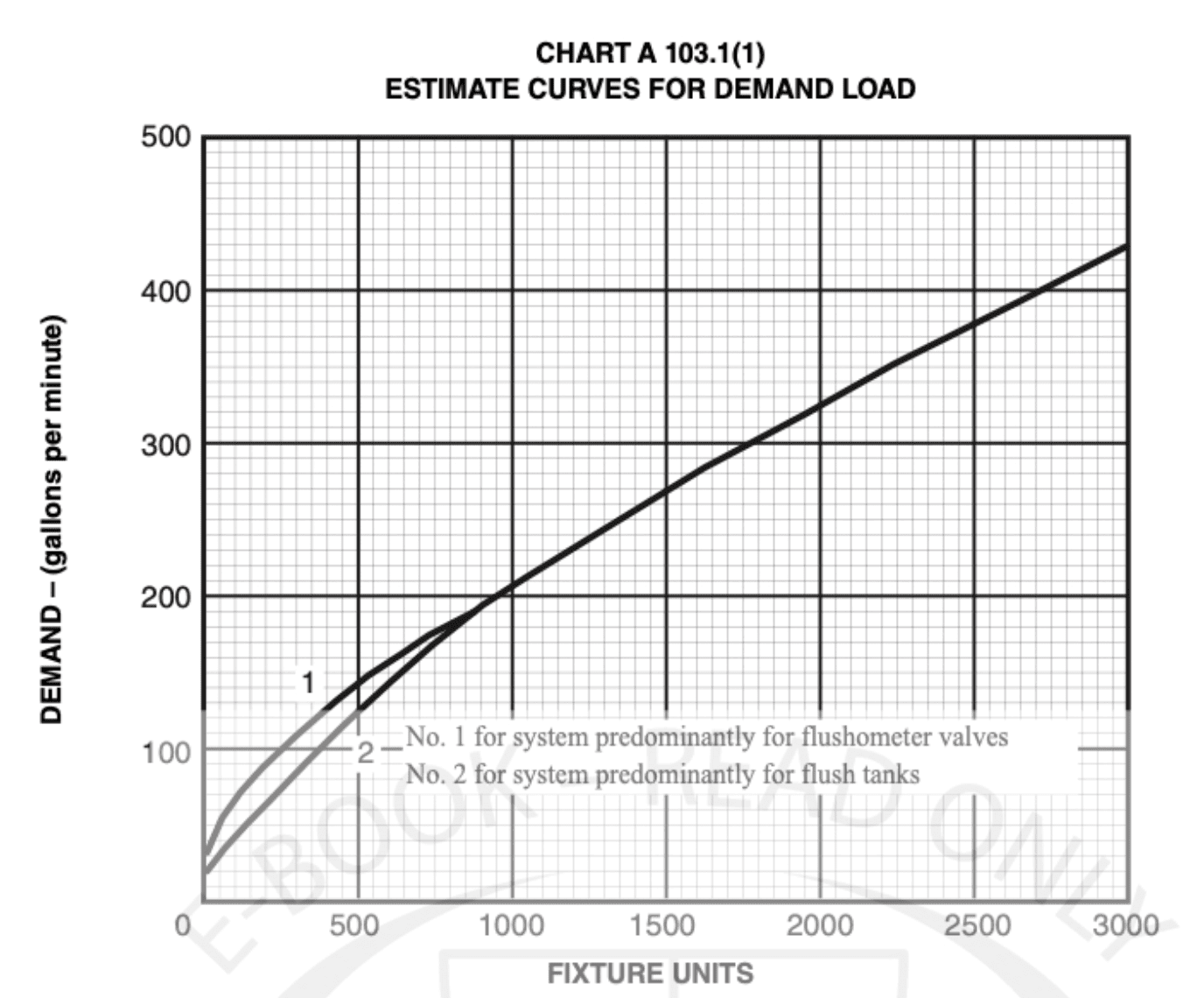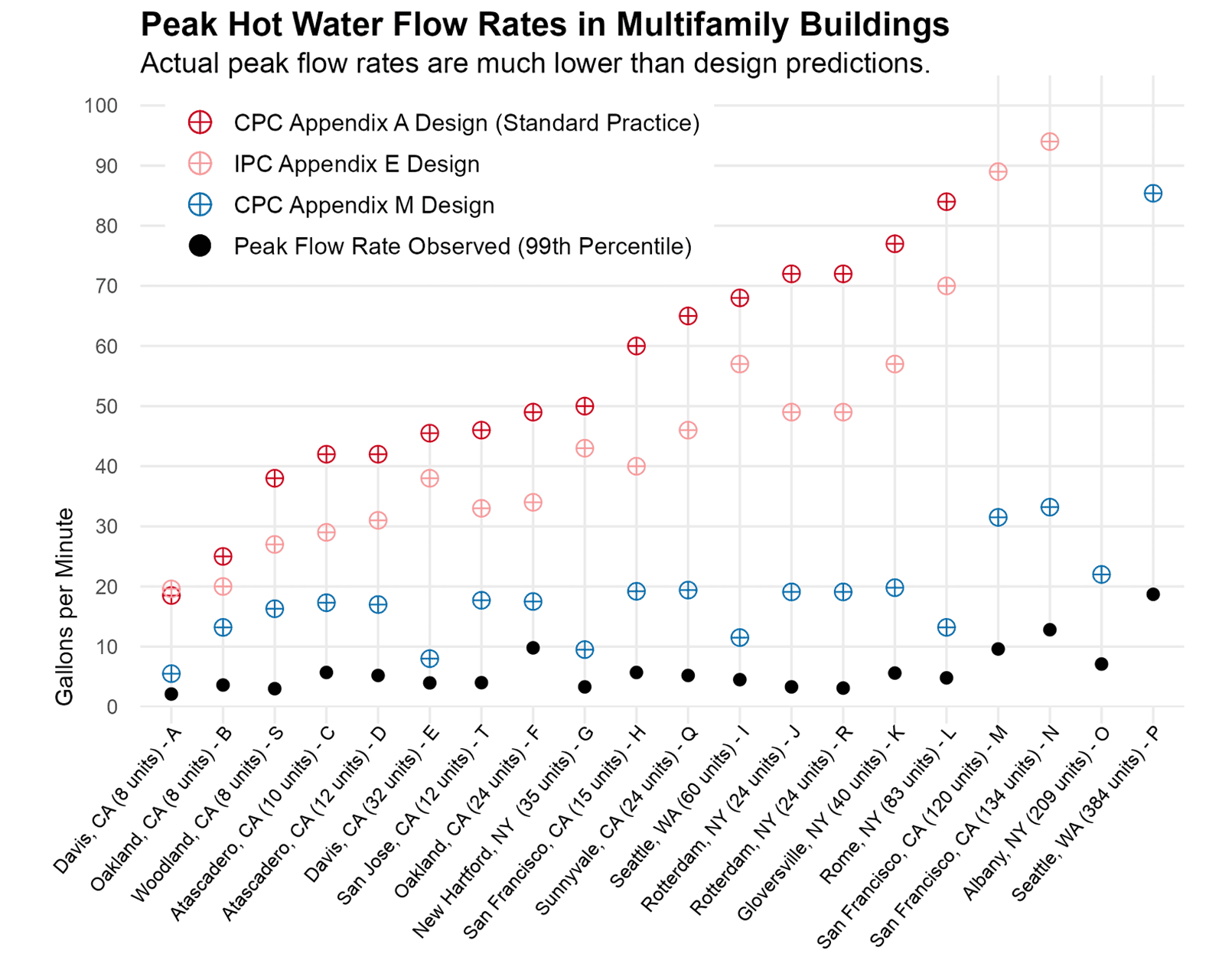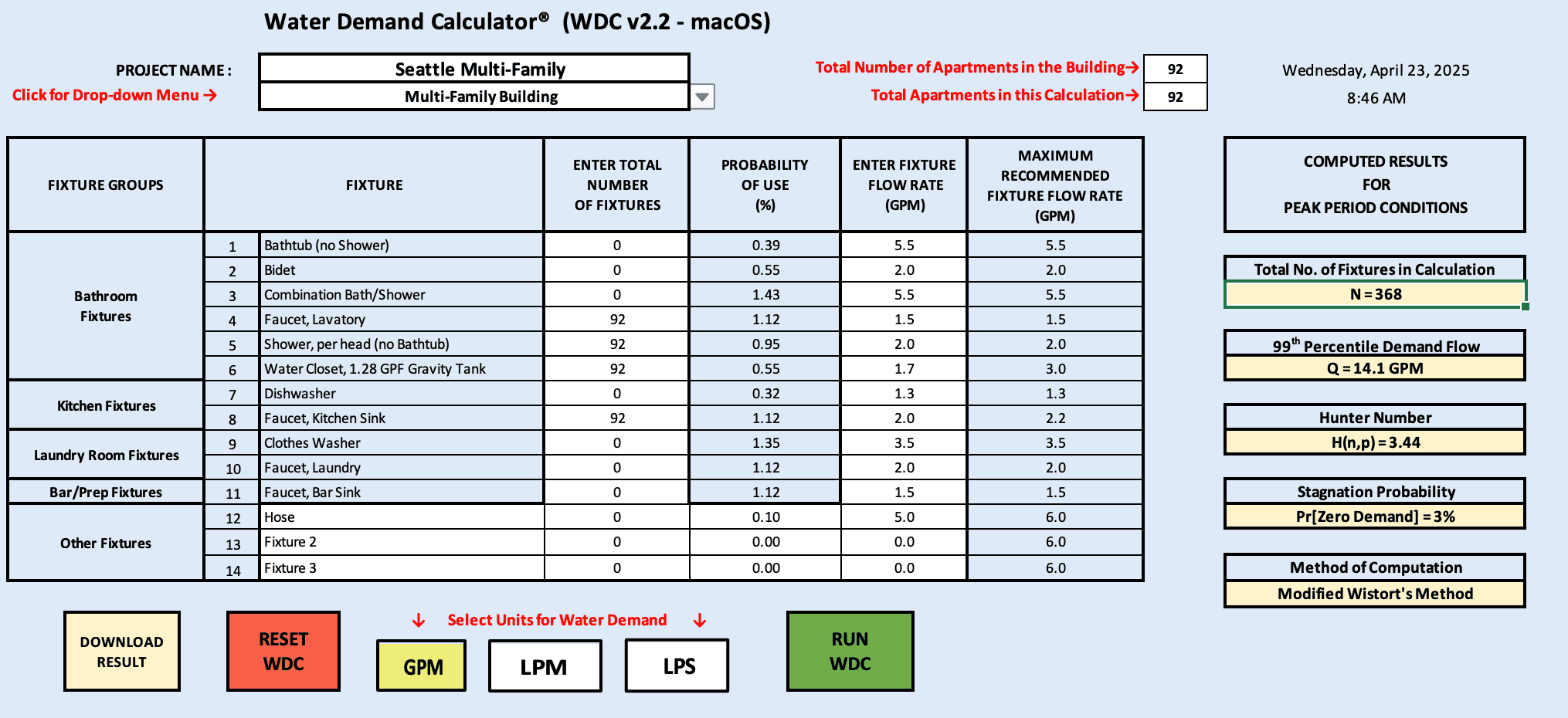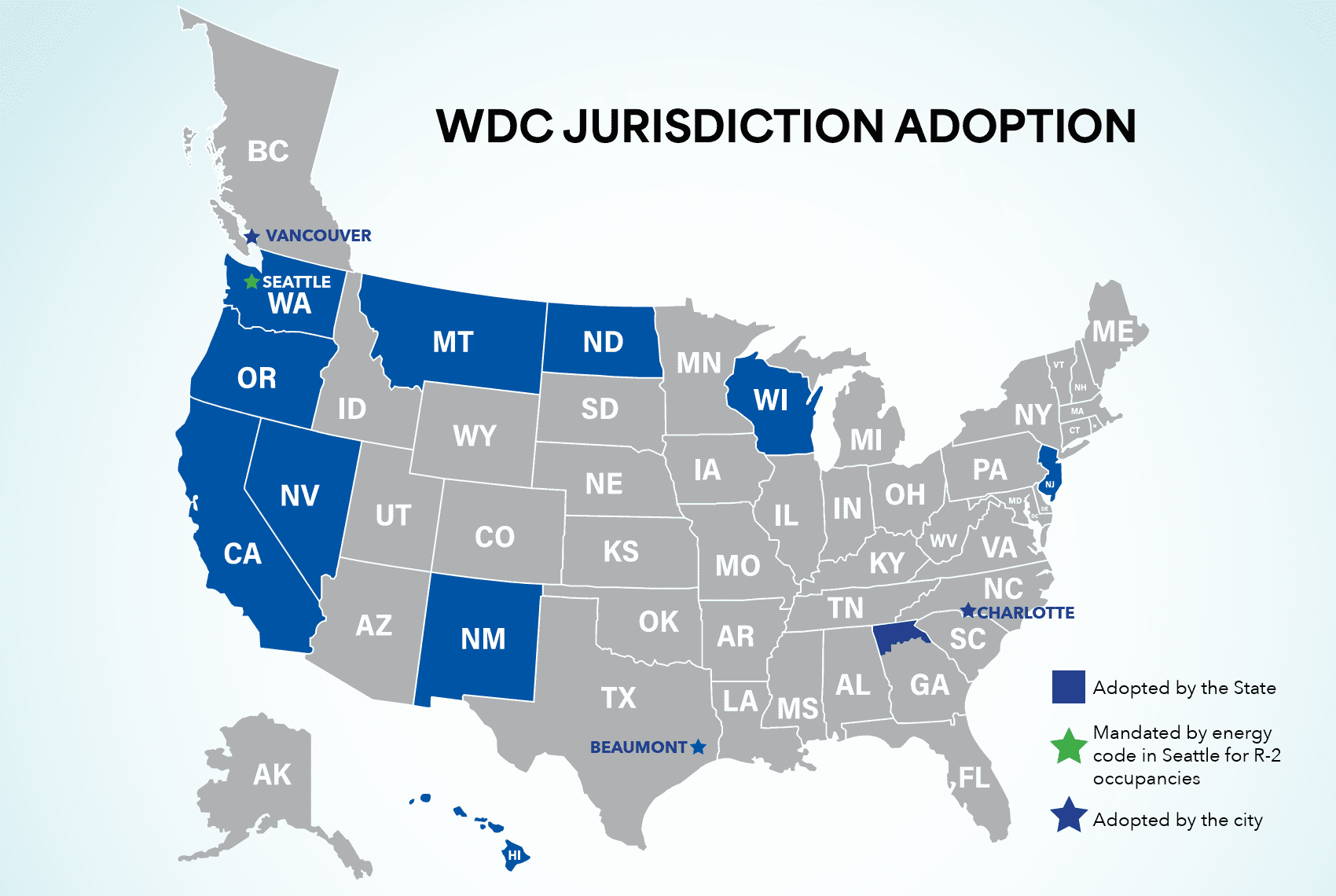
WHAT IS THE WATER DEMAND CALCULATOR?
The methods for sizing residential water supply piping have remained largely unchanged since the early 1940s, when Roy Hunter developed Hunter’s Curve. Although modern plumbing fixtures and appliances consume significantly less water than in the 1940s, the rules for pipe sizing in plumbing codes and standards have not been updated to account for this reduction in total water demand. This outdated sizing methodology leads to wasted energy, water, and construction costs.

UPC Appendix M, otherwise known as the Water Demand Calculator (WDC), provides a modernized method for accurately (but conservatively) estimating the peak demand of the building water supply, branches, and risers for single- and multifamily dwellings. While Hunter’s Curve, as specified in UPC Appendix A, results in design values that are 5 to 27 times larger than observed peak hot water flow rates for multifamily buildings, the WDC calculates design values between 2 and 6 times observed flow rates.
On August 1, 2023, the California Building Standards Commission approved the adoption of the WDC into the California Plumbing Code (CPC), and it is now available for voluntary use for residential occupancies that fall within the jurisdiction of the California Department of Housing and Development. In this blog post, we will explain the benefits of using the WDC, how to use it to calculate peak water demand, and how you can help expand its availability to additional jurisdictions throughout the country.
WHY USE THE WDC?
Plumbing designs based on the WDC result in smaller pipe diameters for the water supply, branches, and risers compared to the current standard practice in UPC/CPC Appendix A. As part of a WDC study published on California’s Statewide Reach Codes Program’s website, water use data for 20 multifamily buildings were collected between 2019 and 2022. The graph below compares the observed peak hot water flow rates to the design values calculated with Hunter’s Curve (CPC Appendix A) and the WDC (CPC Appendix M).

By using the WDC to calculate peak water demand and using these values in UPC Appendix A when sizing water pipes, the following benefits will be realized:
- Water savings from faster hot water delivery, resulting in smaller monthly water and sewer service charges
- Energy savings due to reduced heat loss in the hot water distribution system, particularly in multifamily buildings with a recirculation system
- Reduced public health and safety risk and improved water quality due to shorter water dwell times in plumbing systems
- Construction cost savings due to smaller diameter pipes and fittings, less pipe insulation material, and reduced water service entrance size
For single family and multifamily buildings, the conservative estimates of water savings range from 234 to 1,096 gallons per dwelling unit per year, embedded electricity savings from 1.1 to 5.3 kWh per dwelling unit per year, and natural gas savings from 2.8 to 7.7 therms per dwelling unit per year depending on the residential building type. For multifamily buildings, conservative upfront construction cost savings are estimated to be between $600 and $1,200 per dwelling unit. These benefits can all help jurisdictions meet carbon neutrality or energy efficiency goals.
For a more detailed discussion of the WDC’s benefits and comparisons to Hunter’s Curve, see the full report from California’s Statewide Reach Codes Program: CPC Appendix M: Alternative Methodology for Calculating Peak Water Demand. An executive summary and fact sheet are also available.
Some of the benefits of the WDC were also discussed in a recent New York Times article.
AN EXAMPLE CALCULATION
The WDC is available as an Excel-based tool as well as a free app, developed by the International Association of Plumbing and Mechanical Officials (IAMPO), from the Apple App Store or Google Play. IAPMO has various other WDC resources available, including a user guide and training video.
To use the WDC, simply fill out the spreadsheet in the following sequence:
- Fill in the project name, building type, and number of apartments
- Select units (gallons per minute, liters per minute, or liters per second)
- Enter total number of fixtures and fixture flow rates for each fixture type (white cells in main table)
- Optionally enter name, number, probability of use and flow rate of additional fixture types such as hose bibs
- Select “Run WDC”
After running the WDC, results will be displayed on the right. Results can also be downloaded if necessary. An example calculation for a multifamily building in Seattle is shown in the screenshot below.

For the 92-unit multifamily building shown above, the WDC calculates a peak flow rate of 14 gpm. For the same building with the same plumbing configuration, UPC Appendix A flow methodology would result in an estimated peak flow rate of 127 gpm – over 9 times higher than the WDC calculates! Appendix A flow calculations result in a 3-inch pipe for both the building water supply and the hot water branch, while the WDC flow rates would result in pipe diameters of one inch. In this case, use of the WDC yields a 50% reduction in internal pipe volume for the whole building. The operational cost savings due to less water and energy use will continue for the life of the building.
WHERE HAS THE WDC BEEN ADOPTED?
UPC Appendix M has been adopted by Nevada (2018), North Dakota (2020), Hawaii (2020), Oregon (2021), Montana (2022), New Mexico (2022), New Jersey (2022), Washington (2023), California (2023), and South Dakota (2025). In Wisconsin (2022), the Water Demand Calculator was approved as an alternate standard through the end of May 2027 for single family and multifamily dwellings.
The City of Seattle has adopted the first mandatory use of UPC Appendix M for new construction multifamily buildings in the 2021 Seattle Commercial Energy Code, which is effective as of November 15, 2024.
As part of the Minnesota Conservation Applied Research and Development (CARD) grant program, 2050 Partners is currently analyzing peak water flow data in four Minnesota multifamily buildings. This study is helping to inform the potential adoption of the WDC as part of Minnesota’s upcoming plumbing code update cycle.

FAQS
What is the water demand calculator?
MOREThe Water Demand Calculator is a modern tool used to estimate peak water demand in residential buildings. Unlike outdated methods like Hunter’s Curve, the Water Demand Calculator reflects the lower flow rates of modern fixtures and appliances, helping to right-size plumbing systems, reduce construction costs, and improve water and energy efficiency.
How do I calculate peak demand with the Water Demand Calculator?
MORETo calculate peak water demand using the Water Demand Calculator, users enter the building type, number of units, fixture types, and flow rates. The tool then uses probabilistic modeling to estimate realistic peak flow rates, often resulting in smaller pipe sizes and significant resource savings compared to existing estimation methods.
How do I find my fixture flow rate?
MOREWater flow rate can be measured by timing how long it takes to fill a container with a known volume or by referencing specifications for individual fixtures. The Water Demand Calculator simplifies this by defaulting to standard fixture flow rates or allowing users to input known flow rates, offering an accurate estimate of total peak demand.
What is the average water demand per household?
MOREWater demand varies by location and household size, but the Water Demand Calculator offers a more precise approach than other standard methods like Hunter’s Curve. By using real data from modern fixtures, the WDC estimates demand tailored to specific residential buildings, avoiding oversized plumbing and inefficiencies.
What is the formula for calculating water flow?
MORETraditional water flow estimates often use empirical formulas based on fixture counts and probability. The Water Demand Calculator improves on these by using updated data models that reflect actual usage patterns and fixture types in modern homes, providing more accurate and efficient design guidance.
NEXT STEPS
If you are involved in one or more projects in a jurisdiction that has adopted UPC Appendix M or the WDC as a voluntary measure, we encourage you to take advantage of the WDC’s upfront and ongoing cost savings, water savings, and energy savings.
With statewide adoption, there is also opportunity for local jurisdictions to facilitate the use of the WDC on construction projects and to evaluate whether mandatory use of the WDC is appropriate for local plumbing or building codes. Jurisdictions interested in exploring the mandatory use of the WDC may benefit from reviewing the adopted code language surrounding the WDC in the 2021 Seattle Energy Code. IAPMO has also made sample legislation available.
If you are interested in using the WDC on your projects in a jurisdiction that has not formally adopted the WDC, you may still be able to use it since it is an accepted engineering practice and an approval for specific projects can be requested from an authority having jurisdiction.
We hope this overview has helped you increase your understanding of the Water Demand Calculator. If you are interested in learning more about the WDC or 2050 Partners, we’d love to speak with you.


